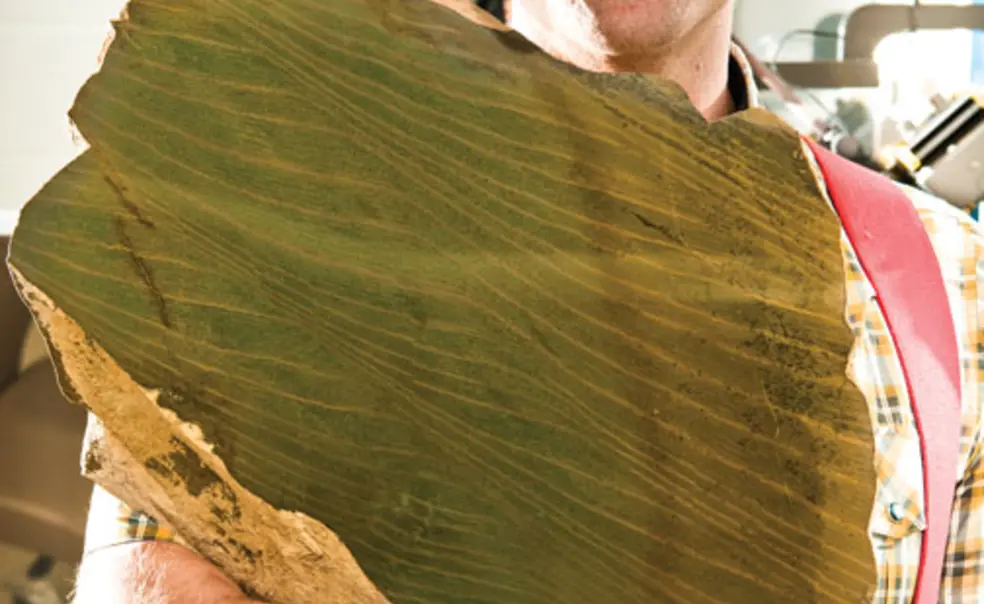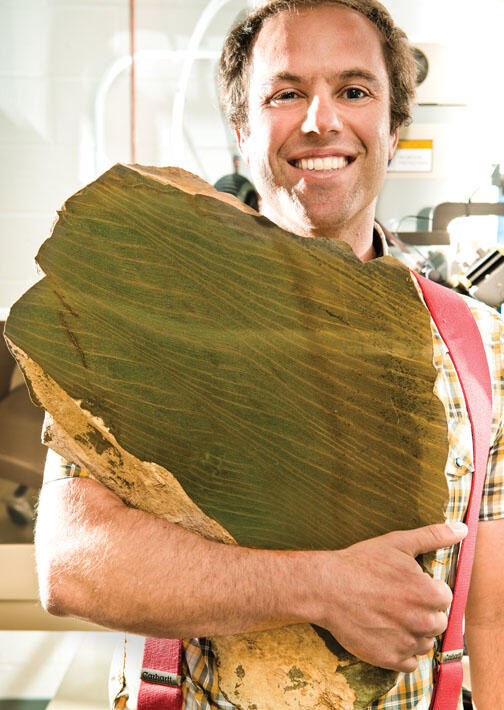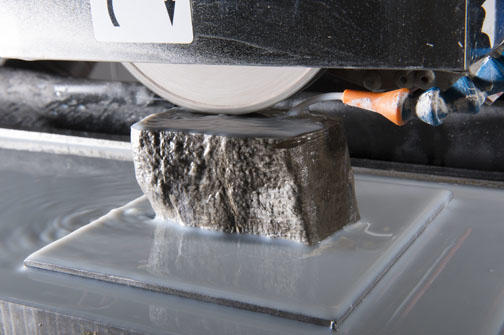Fossils, ancient rocks, and rare meteorites millions or billions of years old — these are just some of the items that Adam Maloof, an associate professor of geosciences at Princeton, is looking forward to feeding to an automated industrial-scale machine that methodically, efficiently, and precisely grinds everything to dust.
“Just for fun,” he says, “we might try a dinosaur bone.”
With a high-pitched whir, the grinding began in earnest in July, obliterating a fossil of Cloudina, a reef-dwelling creature that lived about 550 million years ago.
But the goal is reconstruction and discovery, not desecration. While the end product is worthless, the journey of destroying everything will yield a trove of data to tackle geological and paleontological puzzles.
Maloof and an architecture firm, Situ Studio in Brooklyn, N.Y., have spent a couple of years working on GIRI — a friendly acronym for Grinding Imaging and Reconstruction Instrument. The new imaging laboratory has produced stunning three-dimensional views and revolutionized the way scientists can study rocks and other structures.
The impetus for the project came from an unusual rock in South Australia, where Maloof worked every summer between 2006 and 2011. He and a graduate student, Catherine Rose *12, were studying geologic formations from a time when glaciers reached the tropics. The rock, embedded with striking red shapes, intrigued them.
“I’ve never seen a rock like this anywhere else,” Maloof says. “We literally spent two years walking over that every day.”
The rock had formed out of sediments at the bottom of a tropical sea between 635 million and 660 million years ago, and the red shapes looked like they could be fossils of some very early sea creatures. They also could have been the product of some geological process unrelated to life, and many paleontologists thought that to be the likelier possibility.
Although life started on Earth more than 3 billion years ago, for most of that time, it consisted only of microscopic single-cell organisms. Only later, about 540 million years ago, did more complex animals such as insect-like marine creatures called trilobites arise, a proliferation of species known as the Cambrian Explosion.
That evolutionary transition from single-cell microorganisms to more complex, multicellular animals with hard shells and bones is still murky. Fossils of these creatures are made of pretty much the same stuff as the rock that encases them, which makes it difficult to identify them as fossils and even harder to extract and study them.
“Who knows what these early forms looked like?” Maloof says.
The usual tools of imaging — shooting X-rays or electrons through the sample and observing how they are deflected — are not of much help because there is little variation in density or mineralogy between the fossils and the rocks.
With no easy way to study the strange Australian rock, no one studied it. “It had just been sitting there in a national park, not talked about,” Maloof says. Yet the red shapes were clearly visible, and Maloof turned to a more direct avenue of exploration: grinding.
The shapes seen on the surface of the rock represent two-dimensional cross sections of whatever was embedded inside. These cross sections tell, at best, an incomplete story. A circular cross section, for example, could be a slice of a sphere, but it also could be a slice of a cylinder. The different red shapes could be separate objects, or they could be connected as part of one structure. Grinding the rock, layer by layer, would reveal a series of cross sections, which could be stitched together to reveal the hidden three-dimensional shape.
To grind the Australian rock, Rose took it to a laboratory at the Massachusetts Institute of Technology, where a few years earlier researchers had ground down and then reconstructed a small, enigmatic creature known as Namacalathus, which lived a few million years before the Cambrian Explosion. She spent two weeks of long days grinding away at her rock, 50 millionths of a meter at a time, and taking pictures of each slice. In those two weeks, she made it through a little more than a centimeter of rock.
“We ended up with an archive of pictures that were very difficult to deal with,” Maloof says. The slices rarely were perfectly parallel; the images did not quite line up. And the lighting changed between pictures.
Nevertheless, the Princeton researchers created three-dimensional models, using computer software that compensated for imperfections. Some of the red shapes stacked together into a centimeter-size entity with interconnected interior tunnels. It looked a lot like a sponge, an animal that still lives in modern-day oceans.
The findings, published in the journal Nature Geoscience in 2010, received a mixed reaction. Genetic and molecular data had suggested that the first sponges arose long before the Cambrian, but some researchers found it unconvincing, especially as there is no other evidence of sponges until 80 million years later.
“People who wanted there to be sponges there love it,” Maloof says of the paper. “People who didn’t want there to be sponges there hate it.”
Maloof thought about other grinding projects and how they might be accomplished without requiring the labor of a sacrificial graduate student. He hooked up with a high school classmate, Bradley Samuels, an architect and principal at Situ Studio, to design the machine. The professor wrote a proposal for GIRI, and in late 2011, the National Science Foundation approved it. Princeton chipped in the money to construct a small building next to Guyot Hall to house GIRI.
GIRI’s operation is straightforward. The biggest piece of the 8,000-pound machine is a commercial, computer-controlled grinder. A slice of rock is mounted onto a horizontal platform and shuttled under a mist that removes grime. It then moves back and forth under a diamond-studded grinding wheel, where within about five minutes the wheel pares away a layer of the rock as thin as 0.00025 centimeter — much thinner than a human hair. GIRI blows away the dust and sprays the surface with a mix of oil and water. A rubber squeegee wipes away the excess and presses the oil into the pores of the rock. A custom-built camera then snaps an 80-megapixel picture. The cycle repeats.
“Basically, it’s like we built a car wash and a camera to attach to the thing,” Maloof says.
GIRI is designed to run unattended for a week or longer. The software includes safeguards to ensure that everything is working properly as GIRI systematically destroys the sample. And if anything goes wrong, the machine halts and emails for help.
Those two weeks that Rose spent grinding away at the Australian rock at MIT? GIRI can perform the same act of destruction, more precisely, in a day.
GIRI has attracted the attention not just of paleontologists with enigmatic fossils, but also of scientists eager to explore materials that cannot be examined effectively with common imaging techniques. Susannah Porter, an associate professor of Earth science at the University of California, Santa Barbara, would like to use GIRI to study the early evolution of mineralized skeletons like those in Cloudina and Namacalathus. Others are interested in grinding up certain meteorites to map round mineral grains known as chondrules, to help learn how close to the sun the meteorite originated. Battery researchers say GIRI could help them examine energy-storing materials they have developed.
Princeton professor Catherine Peters and research scholar Jeffrey Fitts, both in the Department of Civil and Environmental Engineering, want to use GIRI to study changes in rocks when the rocks interact with carbon dioxide at high pressures. One of the strategies to mitigate global warming is to capture carbon dioxide before it is released into the atmosphere and inject it deep underground. But geologists do not fully understand what happens underground — which rocks would safely trap the carbon dioxide and which might fracture and allow it to escape.
One of the first things Maloof would like to do is revisit the Australian rock in better detail: “Are they really sponges? Is there diversity? Is it just one species?”
He also would like to explore assemblages of small shell-like fossils in rocks slightly older than the Cambrian Explosion. “Again, it’s an example where there’s no 3-D information,” he says.
In destroying the past, much will be learned.














No responses yet